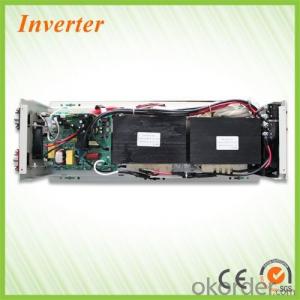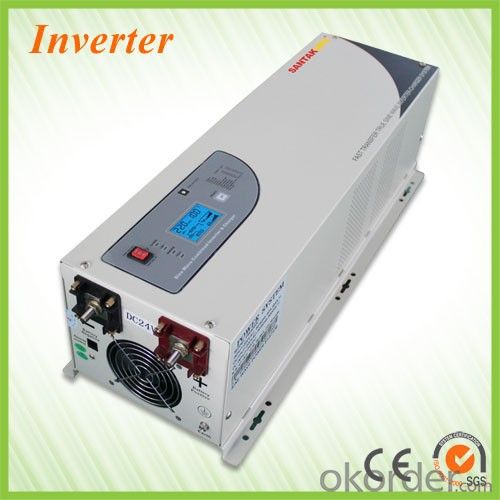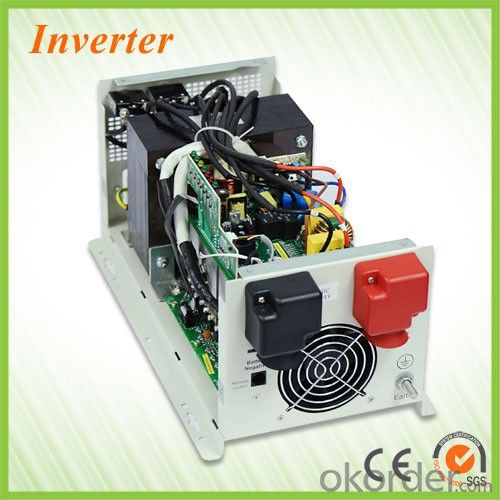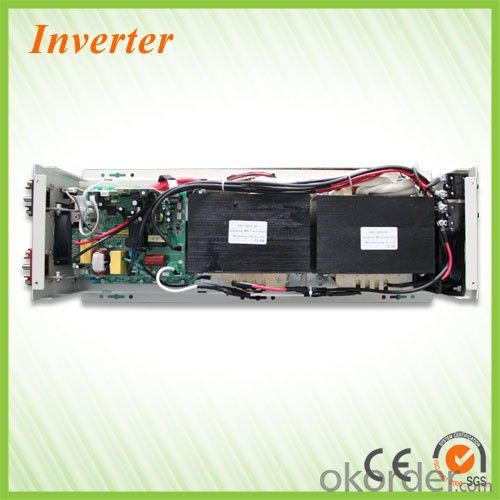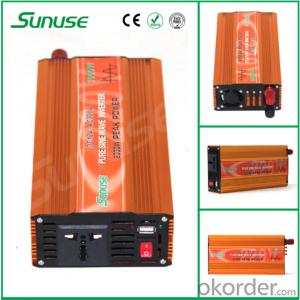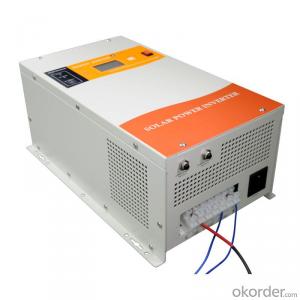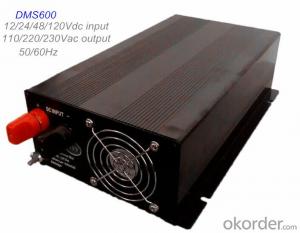2000W Solar Inverter - 2024 Top Selling South Africa EP 3000 48V 6000W Solar Charger Inverter
- Loading Port:
- Ningbo
- Payment Terms:
- TT OR LC
- Min Order Qty:
- 500 pc
- Supply Capability:
- 10000 pc/month
OKorder Service Pledge
OKorder Financial Service
You Might Also Like
2015 Top Selling South Africa EP 3000 48V 6000W Solar Charger Inverter
Features of EP3000 Series 48V 6000W Solar Charger Inverter :
High efficiency over 90%
12Vac/24Vac/48Vac
Max.charge current 70A
Inbuilt pure copper transformer
Automatic three-stage battery Charger
RS232 with free CD(option)
Solar first function(option)
Charge current adjustable(option)
Remote control(option)
CE certificate, Soncap certificate.
Product Picts of EP3000 Series 48V 6000W Solar Charger Inverter :
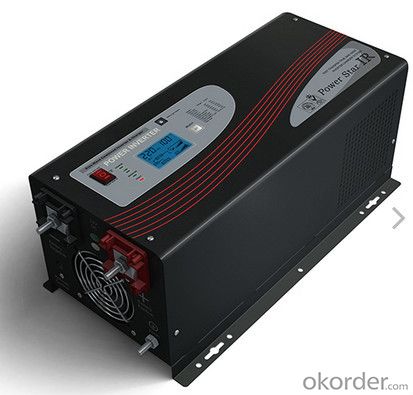
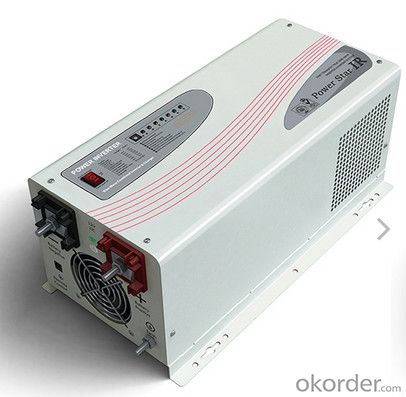
| Rated Capacity | 1000W | 1500W | 2000W | 3000W |
| Efficiency | >90% | |||
| Input | ||||
| Model | 120v Models | 230v Models | ||
| Nominal Voltage | 100V/110V/115V/120V Selectable | 200V/220V/230V/240V Selectable | ||
| Output | ||||
| Rated Power | 1000W | 1500W | 2000W | 3000W |
| Output Voltage | 100V/110V/115V/120V Selectable | 200V/220V/230V/240V Selectable | ||
| Voltage Waveform | Pure Sine Wave | |||
| Crest Factor | 3:1 | |||
| Regulation(Nominal) | ±10% Typical Of Nominal Voltage | |||
| Transfer Time | Transfer Time : AC To DC : 10ms (Typical) Transfer Time : DC To AC : 10ms(Typical ) | |||
| Max Bypass Overload Current | 30A | |||
| Input | ||||
| Nominal Voltage | DC12V/24V | DC12V/24V | DC12V/24V | DC24V/48V |
| Over Current Protection | By Re-Settable Over Current Protector | |||
| Output | ||||
| Nominal Input Voltage | 230Vac | |||
| Input Voltage Range | 185~265Vac | |||
| Nominal Charge Current | 35amp-70amp | |||
| Charger Short Circuit Protection | Circuit Breaker | |||
| Over Charge Protection | Bat. V ≥ 15.7Vdc/31.4Vdc/62.8Vdc Beeps 0.5s Every 1s & Fault After 60s | |||
| Battery Type | Lead-Acid 12Ah ~ 250Ah | |||
| Typical Backup Time | No Limit, Depend on external battery | |||
| Average Charging Current | 35A/20A | 45A/30A | 65A/35A | 75A/30A |
| Battery voltage Option | ||||
| Options 7 | Battery low trip to bypass 11v , high trip to battery 14v | |||
| Options 8 | Battery low trip to bypass 10.5v , high trip to battery 13.5v | |||
| Options 9 | Battery low trip to bypass 10v , high trip to battery 13v | |||
| Communications & Management | ||||
| Control Panel | LCD/LED Option | |||
| Audible Alarm | Alarm On Battery:Low Battery & Battery Over Voltage Alarm On Abnormal Operation: Over Load, Short-Circuit, & Over Heat | |||
| Environment and Safe | ||||
| Operating Temperature | 0℃ To 40℃ (32℉ To 104℉) | |||
| Transit/Storage Temperature | -15℃ To 60℃ | |||
| Audible Noise | 60 Dba Max at 1m | |||
| Quality Control System | ISO 9001,CE,FCC | |||
| Physical | ||||
| Dimensions: (H×D×W) | 570*320*315mm | |||
| G.W (Kg) | 19 | 19 | 22.5 | 27.5 |
| Packing | Export Carton For Each Unit Per Carton | |||


Warrenty
provides a 1~3 year limited warranty (“Warranty”) against defects in materials and workmanship for its Uninterruptible power supply, Power inverter/chargers, Solar charge controllers, Battery Products (“Product”).
The term of this Warranty begins on the Product(s) initial purchase date, or the date of receipt of the Product(s) by the end user, whichever is later. This must be indicated on the invoice, bill of sale, and/or warranty registration card submitted to MUST-Solar. This Warranty applies to the original MUST-Solar Product purchaser, and is transferable only if the Product remains installed in the original use location.
FAQ
1. How do I decide which system is right for me ?
For protection from long outages, include a generator or solar panels in your Must solar system. Shorter outages can be handled by a battery-only system.
2. Where my system will be installed ?
Must solar systems are usually wall-mounted near a home's main electrical (circuit breaker) panel.
3. How do I install my system ?
A must solar backup inverter is connected to a home electric system , we will supply detailed installation manual and videos for our customers .
4. How fast will my system respond to a power outage ?
Must solar inverters typically transfer to battery power in less than 16 milliseconds (less than 1/50th of a second).
- Q: Are there any limitations on the number of solar panels that can be connected to a single inverter?
- Yes, there are limitations on the number of solar panels that can be connected to a single inverter. The maximum number of panels that can be connected depends on various factors such as the power rating of the inverter, the voltage and current ratings of the panels, and the configuration of the system. In general, the inverter should be able to handle the combined power output of all the connected solar panels. If the panels generate more power than the inverter can handle, it may lead to system inefficiencies, reduced performance, or even damage to the inverter. Additionally, the voltage and current ratings of the panels should be within the acceptable range of the inverter. If the panels have a higher voltage or current rating than what the inverter can safely handle, it may result in overloading or malfunctioning of the inverter. Furthermore, the configuration of the solar panels also plays a role in determining the limitations. Panels can be connected in series or parallel, and each configuration has its own requirements and limitations. The inverter needs to be compatible with the specific configuration being used. To ensure proper functioning and optimal performance, it is recommended to consult the manufacturer's guidelines and specifications for both the solar panels and the inverter. These guidelines will provide information on the maximum number of panels that can be connected to a single inverter and any other specific limitations or requirements that need to be considered.
- Q: What is the role of a solar inverter in voltage support?
- The role of a solar inverter in voltage support is to convert the direct current (DC) generated by solar panels into alternating current (AC) that is compatible with the electrical grid. Additionally, it helps regulate the voltage levels to ensure a steady and consistent supply of electricity to the grid, thereby supporting voltage stability.
- Q: What is the maximum DC input current for a solar inverter?
- The maximum DC input current for a solar inverter can vary depending on the specific model and manufacturer. It typically ranges from 10 to 60 amps, but it is best to consult the product specifications or contact the manufacturer for the exact maximum DC input current of a particular solar inverter.
- Q: Can a solar inverter be used in systems with different module tilts?
- Yes, a solar inverter can be used in systems with different module tilts. Solar inverters are designed to convert the DC power generated by solar panels into AC power for use in the electrical grid. They are compatible with a wide range of module tilts and orientations, allowing flexibility in system design and installation.
- Q: What is the role of a solar inverter in a grid-tied system?
- The role of a solar inverter in a grid-tied system is to convert the direct current (DC) electricity produced by the solar panels into alternating current (AC) electricity that can be used by the electrical grid or consumed by the appliances and devices in a home or business. It also ensures that the solar energy generated is synchronized with the grid's voltage and frequency to enable efficient and safe transfer of power. Additionally, the solar inverter monitors and controls the flow of electricity between the solar panels, the grid, and any energy storage systems that may be connected to the system.
- Q: What is the role of a power control feature in a solar inverter?
- The role of a power control feature in a solar inverter is to efficiently manage and optimize the power output generated by the solar panels. It helps regulate the flow of electricity, maintaining a stable voltage and frequency, while also ensuring that the maximum power point tracking (MPPT) is achieved. This feature allows for better performance, increased energy production, and the ability to adapt to changing sunlight conditions, ultimately maximizing the overall efficiency of the solar inverter system.
- Q: Can a solar inverter be used in systems with different module types?
- Yes, a solar inverter can be used in systems with different module types. Solar inverters are designed to convert the DC power generated by solar panels into usable AC power for homes or businesses. They typically have a wide input voltage range and are compatible with various module types, including monocrystalline, polycrystalline, and thin-film panels. However, it is essential to ensure that the inverter's specifications are compatible with the specific module types being used to optimize efficiency and performance.
- Q: Can a solar inverter be used in a stand-alone solar system?
- Yes, a solar inverter can be used in a stand-alone solar system. In fact, it is an essential component as it converts the direct current (DC) generated by the solar panels into alternating current (AC) that can be used to power electrical devices in a standalone system.
- Q: What is the maximum efficiency rating of a solar inverter?
- The maximum efficiency rating of a solar inverter can vary depending on the specific model and technology used, but generally, the highest efficiency ratings can range from 95% to 99%.
- Q: Can a solar inverter be used in areas with high electromagnetic radiation?
- Yes, a solar inverter can be used in areas with high electromagnetic radiation. However, it is important to note that the performance and reliability of the inverter may be affected by the presence of high electromagnetic radiation. High radiation levels can potentially cause electromagnetic interference (EMI) which may disrupt the functioning of the inverter and lead to reduced efficiency or even failure. Therefore, it is recommended to take necessary precautions such as proper grounding, shielding, and selecting inverters with robust EMI protection mechanisms when installing solar inverters in areas with high electromagnetic radiation. Additionally, it is advisable to consult with experts or manufacturers who can provide guidance on specific models of solar inverters that are designed to withstand and perform well in high electromagnetic radiation environments.
Send your message to us
2000W Solar Inverter - 2024 Top Selling South Africa EP 3000 48V 6000W Solar Charger Inverter
- Loading Port:
- Ningbo
- Payment Terms:
- TT OR LC
- Min Order Qty:
- 500 pc
- Supply Capability:
- 10000 pc/month
OKorder Service Pledge
OKorder Financial Service
Similar products
Hot products
Hot Searches
Related keywords


